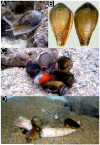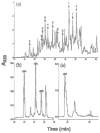Evolution of Conus peptide toxins: analysis of Conus californicus Reeve, 1844
- PMID: 20363338
- PMCID: PMC3488448
- DOI: 10.1016/j.ympev.2010.03.029
Evolution of Conus peptide toxins: analysis of Conus californicus Reeve, 1844
Abstract
Conus species are characterized by their hyperdiverse toxins, encoded by a few gene superfamilies. Our phylogenies of the genus, based on mitochondrial genes, confirm previous results that C. californicus is highly divergent from all other species. Genetic and biochemical analysis of their venom peptides comprise the fifteen most abundant conopeptides and over 50 mature cDNA transcripts from the venom duct. Although C. californicus venom retains many of the general properties of other Conus species, they share only half of the toxin gene superfamilies found in other Conus species. Thus, in these two lineages, approximately half of the rapidly diversifying gene superfamilies originated after an early Tertiary split. Such results demonstrate that, unlike endogenously acting gene families, these genes are likely to be significantly more restricted in their phylogenetic distribution. In concordance with the evolutionary distance of C. californicus from other species, there are aspects of prey-capture behavior and prey preferences of this species that diverges significantly from all other Conus.
Copyright 2010 Elsevier Inc. All rights reserved.
Figures





References
-
- Bouchet P, Rocroi J-P. Classification and nomenclator of Gastropods families. Malacologia. 2005;47
-
- Chipman AD. On making a snake. Evol Dev. 2009;11:3–5. - PubMed
-
- Chippaux JP, Williams V, White J. Snake venom variability: methods of study, results and interpretation. Toxicon. 1991;29:1279–1303. - PubMed
Publication types
MeSH terms
Substances
Grants and funding
LinkOut - more resources
Full Text Sources
Other Literature Sources

